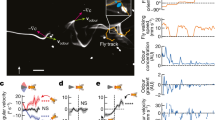Abstract
This paper deals with anemotactic strategies of searching for odour plumes under conditions of variation in wind direction and equal energy costs involved in moving a unit path length in any direction in the x, y plane. It is generally accepted that cross-wind searching is the best searching strategy to acquire a maximum amount of information. This is of course true, if the wind is unidirectional. A geometrical model of anemotactic searching is presented that takes into account variation in wind direction. It is shown, that, if wind direction fluctuates over a range larger than 30 degrees from the mean wind direction, then upwind or downwind searching is the best strategy and cross-wind searching is the worst of all possibilities.
Similar content being viewed by others
References
Bell WJ, Tobin TR (1982) Chemo-orientation. Biol Rev 57:219–260
David CT, Kennedy JS, Ludlow AR, Perry JN, Wall C (1982) A reappraisal of insect flight towards a distant point source of wind-borne odour. J Chem Ecol 8(9):1207–1216
Gillies MT, Wilkes TJ (1974) Evidence for downwind flights by host-seeking mosquitoes. Nature 252:388–389
Kennedy JS (1977) Olfactory responses to distant plants and other odor sources. In: Chemical Control of insect Behavior: Theory and Application (Shorey HH, McKelvey JJ, eds):67–91. John Wiley & Sons, New York
Kennedy JS (1978) The concepts of olfactory ‘arrestment’ and ‘attraction’. Physiol Entomol 3:91–98
Kennedy JS (1983) Zigzagging and casting as a programmed response to wind-borne odour: a review. Physiol Entomol 8:109–120
Linsenmair KE (1969) Anemomenotaktische Orientierung bei Tenebrioniden und Mistkäfern (Insecta, Coleoptera). Z vergl Physiol 64:154–211
Linsenmair KE (1973) Die Windorientierung laufender Insekten. Fortschr Zool 21:59–79
Murlis J, Jones CD (1981) Fine-scale structure of odour plumes in relation to insect orientation to distant pheromone and other attractant sources. Physiol Entomol 6:71–86
Pasquill F (1974) Atmospheric Diffusion. The dispersion of Windborne Material from Industrial and other Sources. Ellis Harwood, Limited, Chichester, p 429
Spencer Johnston J (1982) Genetic variation for anemotaxis (wind-directed movement) in laboratory and wild-caught populations of Drosophila. Behav Genet 12(3):281–293
Author information
Authors and Affiliations
Rights and permissions
About this article
Cite this article
Sabelis, M.W., Schippers, P. Variable wind directions and anemotactic strategies of searching for an odour plume. Oecologia 63, 225–228 (1984). https://doi.org/10.1007/BF00379881
Received:
Issue Date:
DOI: https://doi.org/10.1007/BF00379881




